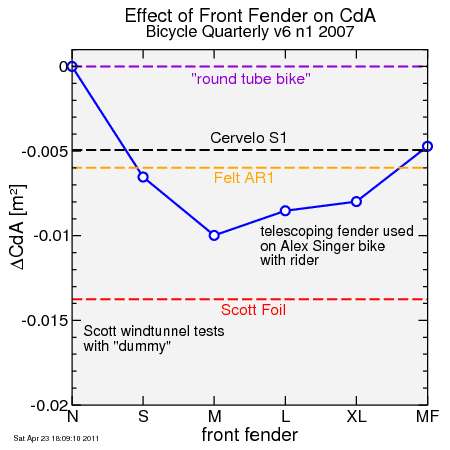"aero road frame" versus front fender
I'm working my way backwards through Bicycle Quarterly and am currently at the Fall 2007 edition. There's a very interesting article there: Jan Heine went to the wind tunnel to test his Alex Singer Randonneuring bike with various options. One of the tests was the effect of a front fender.

As he expected, the front fender appeared to reduce wind resistance. He used a telescoping fender to test the effect of length. I plot the result here: "N" corresponds to no fender, "S" for short, "M" for medium length, "L" for long, "XL" for extra-long, and "MF" for a mud-flap on an extra-long fender.

There appears to be an optimal length: the fender blocks the wind from entering the brake area, then going longer than that is counter-productive.
Jan dismisses the effect as relatively small. However, ignoring his "repeatability" tests to establish error bars, I'll plot the naked numbers of the difference in CdA from the fenders to the difference in CdA reported by Scott for "aero" mass-start bike frames relative to a "round-tube" frame, my guess the long-head-tubed Scott CR1. Scott's tests were with a dummy mounted on the bike. Jan's tests were with a rendered outline on a display against which is aligned an image of his body for repeatability when conducting the wind tunnel tests. I use the zero-yaw data from the Scott test since that is how the fender test was done.

Curiously, the short front fender seems to offer a greater advantage than the Cervelo and Felt, and not much less than the Scott Foil. Velo Orange fenders cost around $60. The Scott Foil frame is probably around $3500.

As he expected, the front fender appeared to reduce wind resistance. He used a telescoping fender to test the effect of length. I plot the result here: "N" corresponds to no fender, "S" for short, "M" for medium length, "L" for long, "XL" for extra-long, and "MF" for a mud-flap on an extra-long fender.

There appears to be an optimal length: the fender blocks the wind from entering the brake area, then going longer than that is counter-productive.
Jan dismisses the effect as relatively small. However, ignoring his "repeatability" tests to establish error bars, I'll plot the naked numbers of the difference in CdA from the fenders to the difference in CdA reported by Scott for "aero" mass-start bike frames relative to a "round-tube" frame, my guess the long-head-tubed Scott CR1. Scott's tests were with a dummy mounted on the bike. Jan's tests were with a rendered outline on a display against which is aligned an image of his body for repeatability when conducting the wind tunnel tests. I use the zero-yaw data from the Scott test since that is how the fender test was done.

Curiously, the short front fender seems to offer a greater advantage than the Cervelo and Felt, and not much less than the Scott Foil. Velo Orange fenders cost around $60. The Scott Foil frame is probably around $3500.

Comments
You mentioned he also did "repeatability" runs...how much variation across runs was there?
3 runs were done w/ a bare frame yielding 8.14, 8.16, and 8.16 N. Runs done with a rider and bike were 26.06, 25.74, and 26.36 N, all at 22 mph. But it is noted that rides done close in time tend to be more repeatable than those done hours apart or, worse, on separate days (tests were done on two days). The fender tests, which focus on forward extension of the fender, were likely done within a short time interval. The smoothness of the curve appears to indicate a lack of random noise, although a systematic drift cannot be ruled out.
Unfortunately, with the Scott wind tunnel test, we have virtually no information about protocol, and for the Tour magazine test, I cannot read the German (my copy is only scanned, so I can't easily send it to Google Translate, either). There is clearly the opportunity for substantial variability in these tests, so data needs to be treated sceptically. For example why would the Foil, which was comparable, maybe slightly inferior to, the Cervelo S3 and Felt AR1 suddenly have less drag with a dummy rider? Some advantage of the Cervelo and Felt neutralized by the rider? I don't know what that would be. Or maybe the dummy placement wasn't perfectly the same? That seems more likely to me.
Also, I didn't understand that the lengths were in relation to forward extension. Any dimensions that correspond to the "S, M, L, etc."?
Interesting that apparently redirecting air away from the brake area using a fender resulted in a CdA drop of ~.010 m^2...and yet some folks have a hard time believing that just streamlining the brake itself could result in an ~.005 m^2 reduction in CdA :-)
BTW, the "repeatability" numbers I gave were spread out over two days. It seems a major source of variability is clothing. Jan wore a wool jersey, which if it has folds in different position can affect Cd, even if A is matched. A skin suit would have been better, even if the purpose of the test was "real-world" conditions for Paris-Brest-Paris.
Wool jersey?